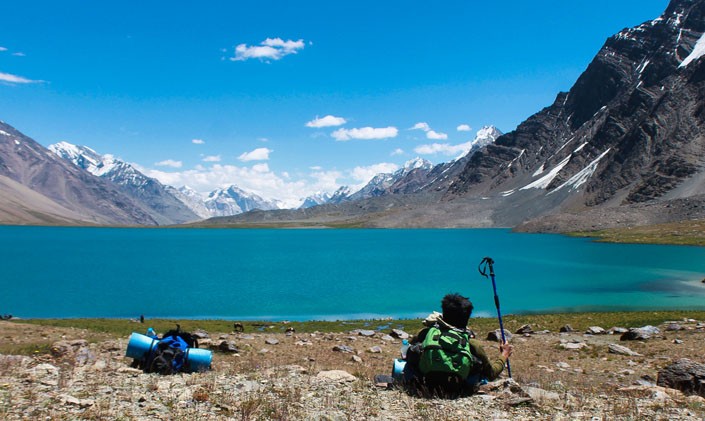
The condition of existing wetlands is gradually deteriorating which need to be conserved

Climate change affects all sectors of life but its effects on natural resources are more pronounced. It is a pervasive threat to species’ survival and health of ecosystems. Wetlands are one of the natural resources that are affected by climate change phenomenon thereby affecting not only the biodiversity they support but also affect the livelihood of millions of wetland dependant people.
The Convention on Biological Diversity and the Ramsar Convention has recognised the link between socio-economic development, poverty, and natural assets. Under Goal 7 of the MDGs, four indicators have direct/ indirect link with wetlands. Loss of wetlands due to anthropogenic activities and climate change will render irreparable loss to human beings and ecosystems which will undermine the sustainable livelihood development approaches.
Wetlands are mainly the product of glaciers and rains. Increased temperature will accelerate melting of glaciers and disrupt rain pattern which is one of the factors contributing towards drying out of fragile wetlands ecosystems. The drought and desertification factors in the wake of climate change will also affect livelihood of local communities at large scale.
Pakistan lies at the crossroads of Asia’s major migratory routes of fauna. There are 225 wetlands of high significance in Pakistan. Diversity of freshwater and marine wetlands covers nearly 10 per cent of the country. In our country, wetlands support over 130 million human population. These wetlands supporting diversity of species have intrinsic values. These wetlands support eighteen threatened mammalian species including Indus River Dolphin, besides twenty birds’ species, twelve reptilian species, and over 190 freshwater fish species. The high altitude alpine wetlands are of unique characteristic such as Kurambar Lake and Saucher Lake over 4100m elevation.
Biotic factors coupled with climate change have far reaching impacts. An increase in the frequency of both of them will register direct loss to these ecological entities. Majority of population that dwells in the rural areas also exerts high pressure on the natural resources especially on the fragile wetland ecosystem. They support the local economies of the upstream and downstream communities. Irrigation is one of the most important functions of the wetlands which play key role in livelihood development of the local people.
Climate change will ultimately decrease the water yield and resultantly hit the biodiversity, people, their crops, and livestock with a chain reaction effect.
The contributions of wetlands to the uplift of local economy can not be overlooked. The local people not only benefit from the substantial economic growth but these ecosystems are also a source of staple food, livestock grazing and fodder, fuel-wood, transport, energy generation and irrigation.
Around the world about one billion people eat fish as wetlands product, in addition to crab, shrimp, and salmon. They provide balanced nutrition and good health prospects to the local people because they are valuable sources of protein and micronutrients. Wetlands are also a source of rice staple food of over 3 billion people throughout the world.
Apart from this the local people also graze their livestock. The local communities also use wetlands for transportation purposes to meet their needs. In addition to this they extract emergent or floating vegetation for fuel and fodder and also use them in preparation of mats, baskets, and ropes.
Wetlands promote eco-tourism opportunities in an area where thousand of people come for recreation by virtue of their aesthetic values. Lake Saiful Maluk, Haliji Lake, Kinjar Lake to mention a few attract thousands of tourists every year. The local people in many areas have set up their shops to earn their living from such development opportunities.
According to an estimate every year millions of tourists visit wetlands for sight seeing, wildlife observation, hiking, trekking, boating and photography. All these activities contribute towards the development of local economy which contributes towards poverty alleviation.
In developing countries like Pakistan, wetlands play a significant role in building not only local economy but also national economy at large. This as a trade off contributes towards effective wetlands conservation.
In addition, these ecosystems provide essential habitats for a number of important mammal species like the smooth coated otter, Indus dolphin, fishing cat, hog deer and waterfowl. They connect nations through water flow and the migratory birds and fauna that migrate from one country to the other.
The increased human demand from the wetlands contributes towards growing biotic pressure which has posed large scale threats to physical existence of the existing wetlands on account of unsustainable practices and lack of awareness at large. Conversion, diversion, agriculture expansion and changed land use practices, increased sedimentation, drainage, pollution, hunting, and over-exploitation of wetland resources are some of the contributing drivers that bring about significant changes in the ecology of the wetlands.
Destructive fishing practices are also serious threats to the aquatic fauna. Due to these factors both wildlife and million of people worldwide have equally suffered who derive wide range of benefits from wetlands. It presents a sad reality that the condition of the existing wetlands is gradually deteriorating which needs to be conserved through wise use approach as our natural assets through active participation of the local people. This is important in the sense because both anthropogenic interference and climate change are the two main contributing factors causing deterioration of wetlands.
Given sustainable utilisation scenario and climate change adaptation measure, wetland will keep on delivering services in ecological perspective for the benefit of the wetlands-dependant communities. This is possible with integrated management practices in agriculture, fisheries, irrigation, wildlife, and tourism sectors.